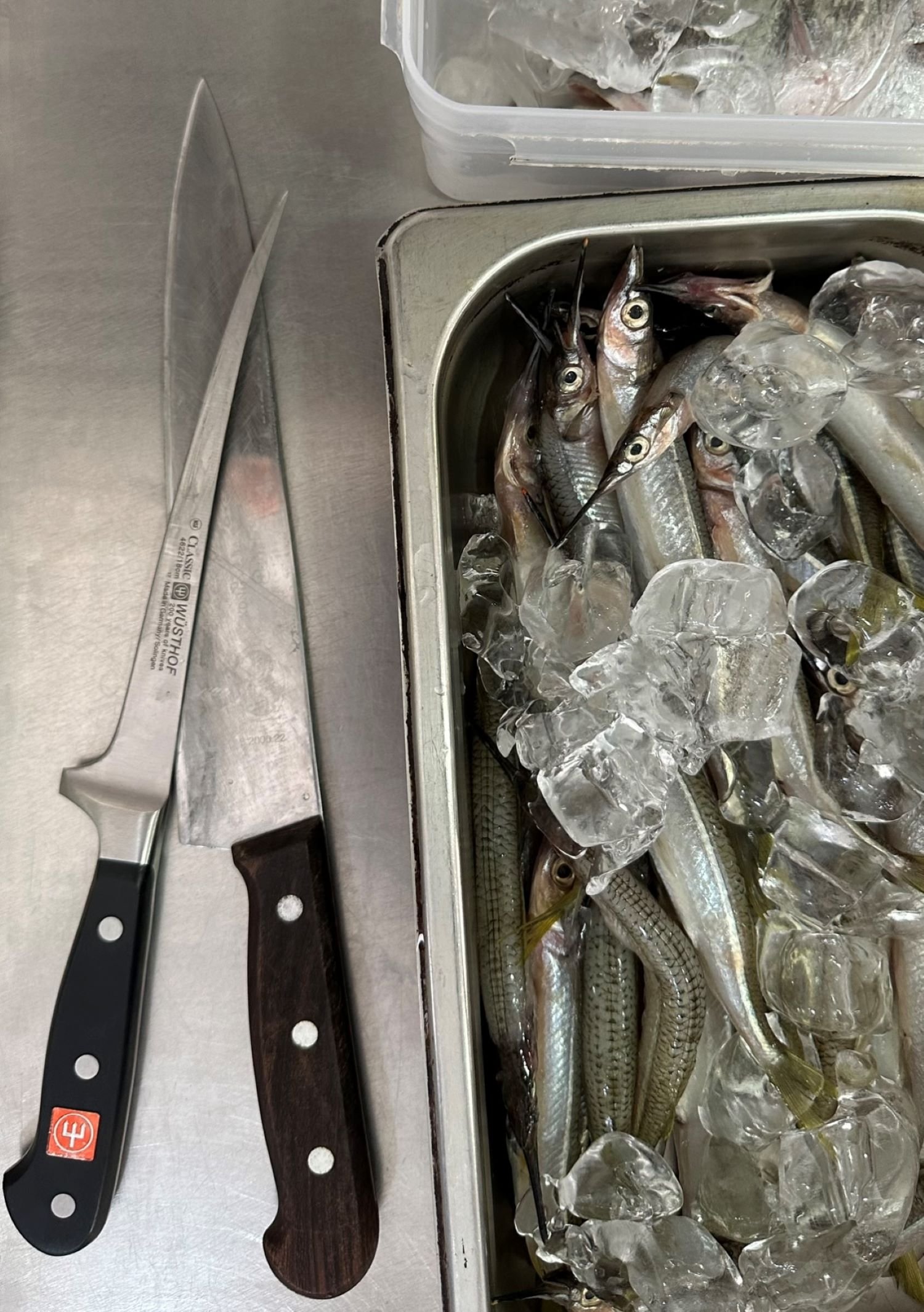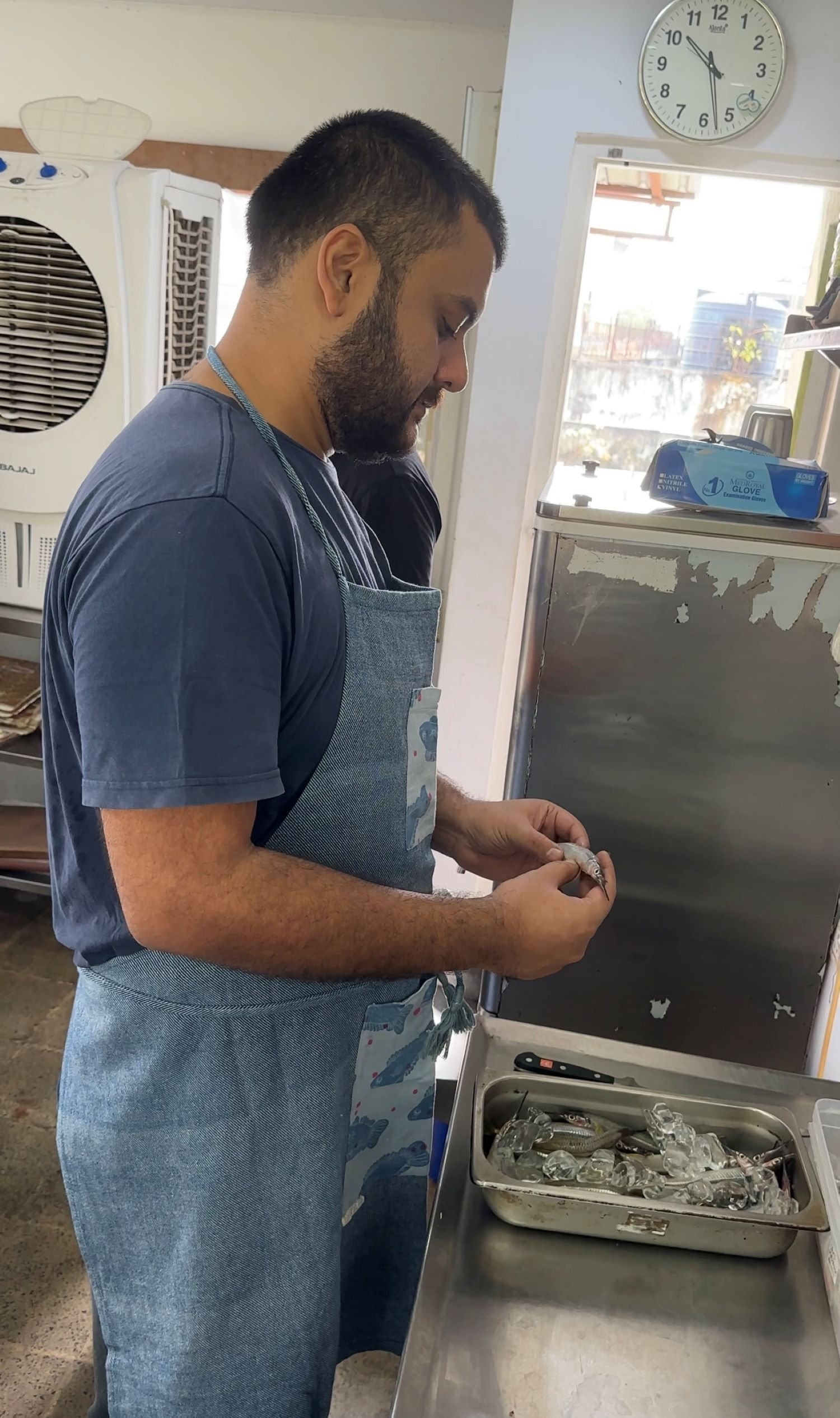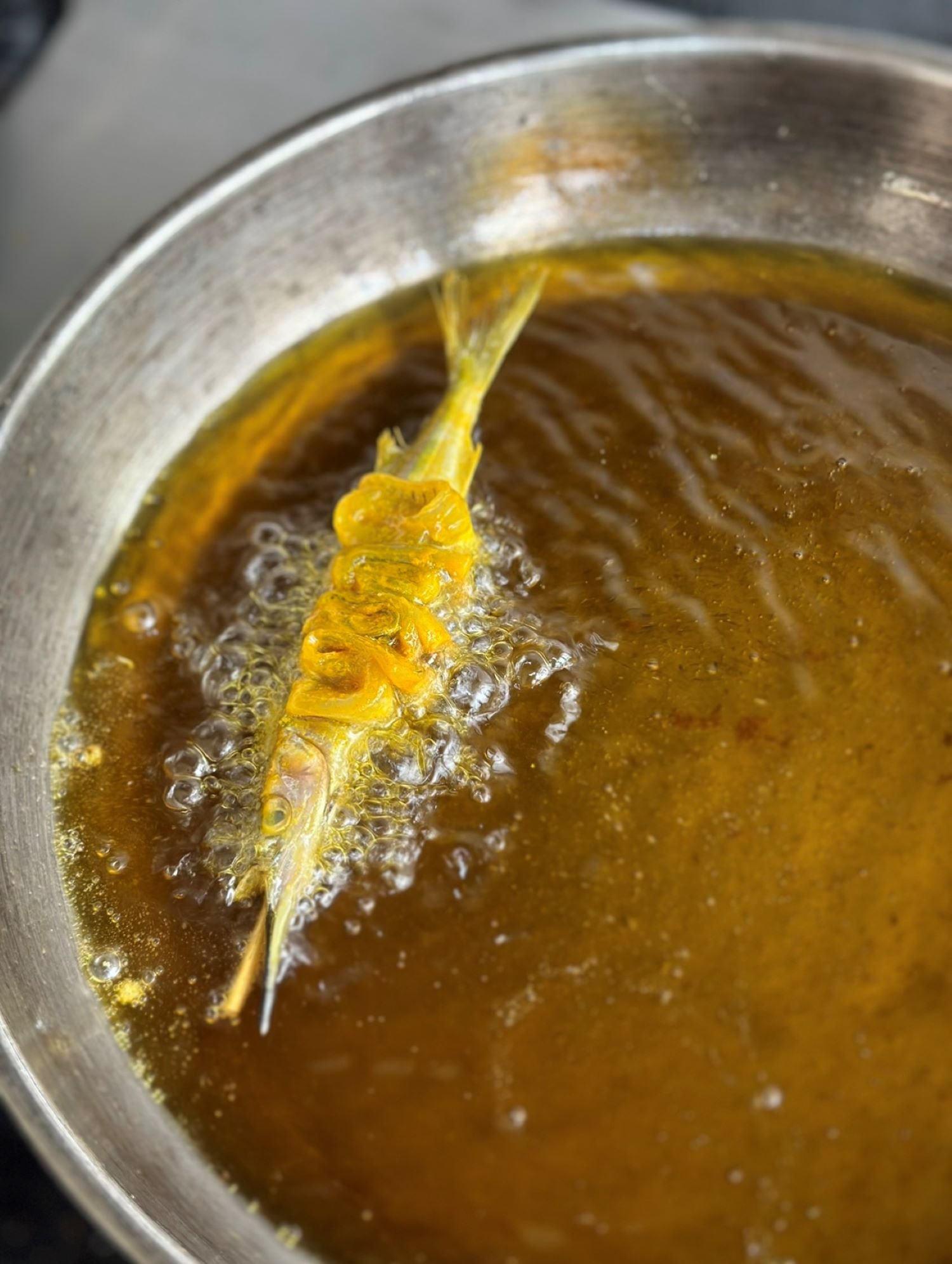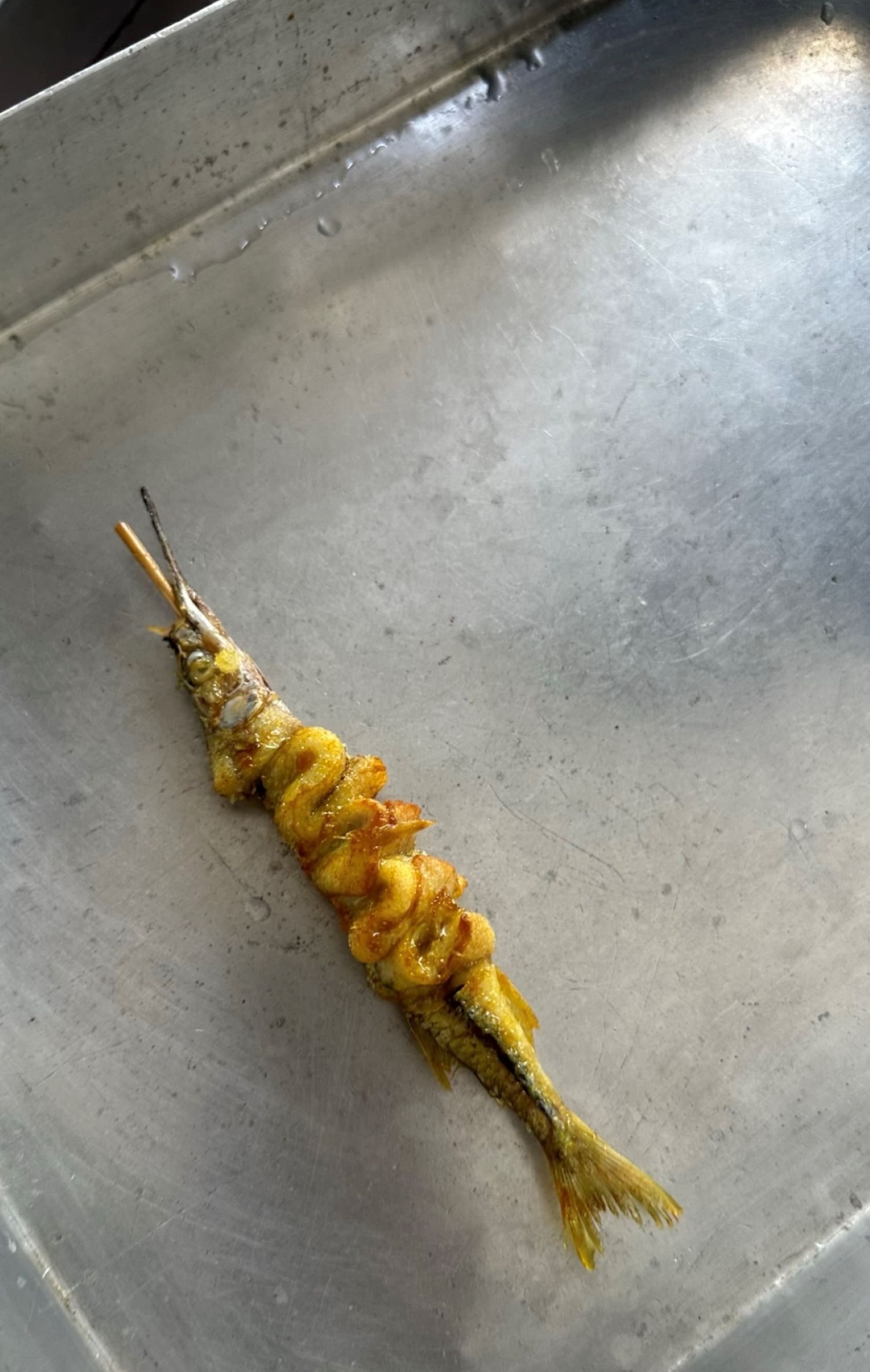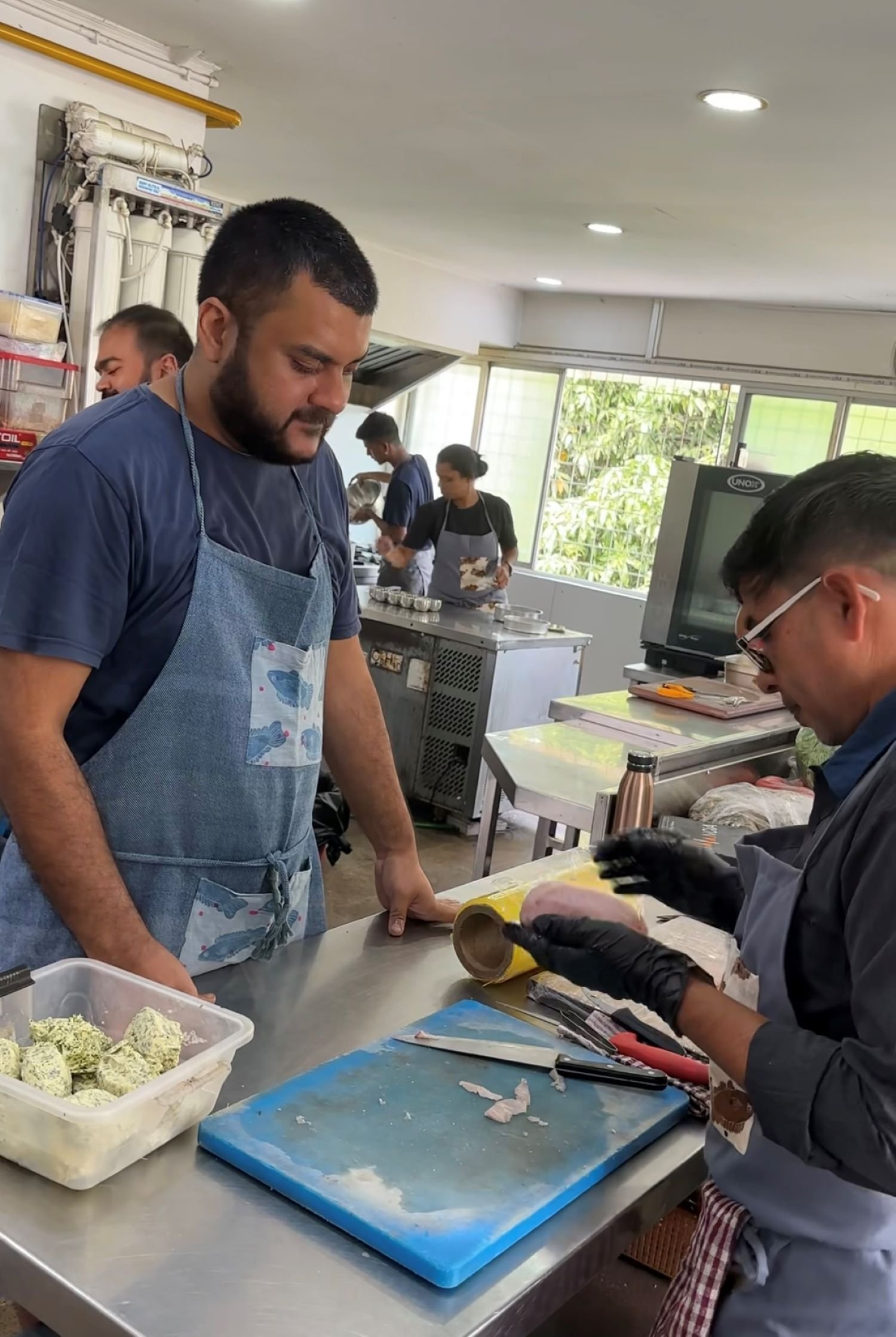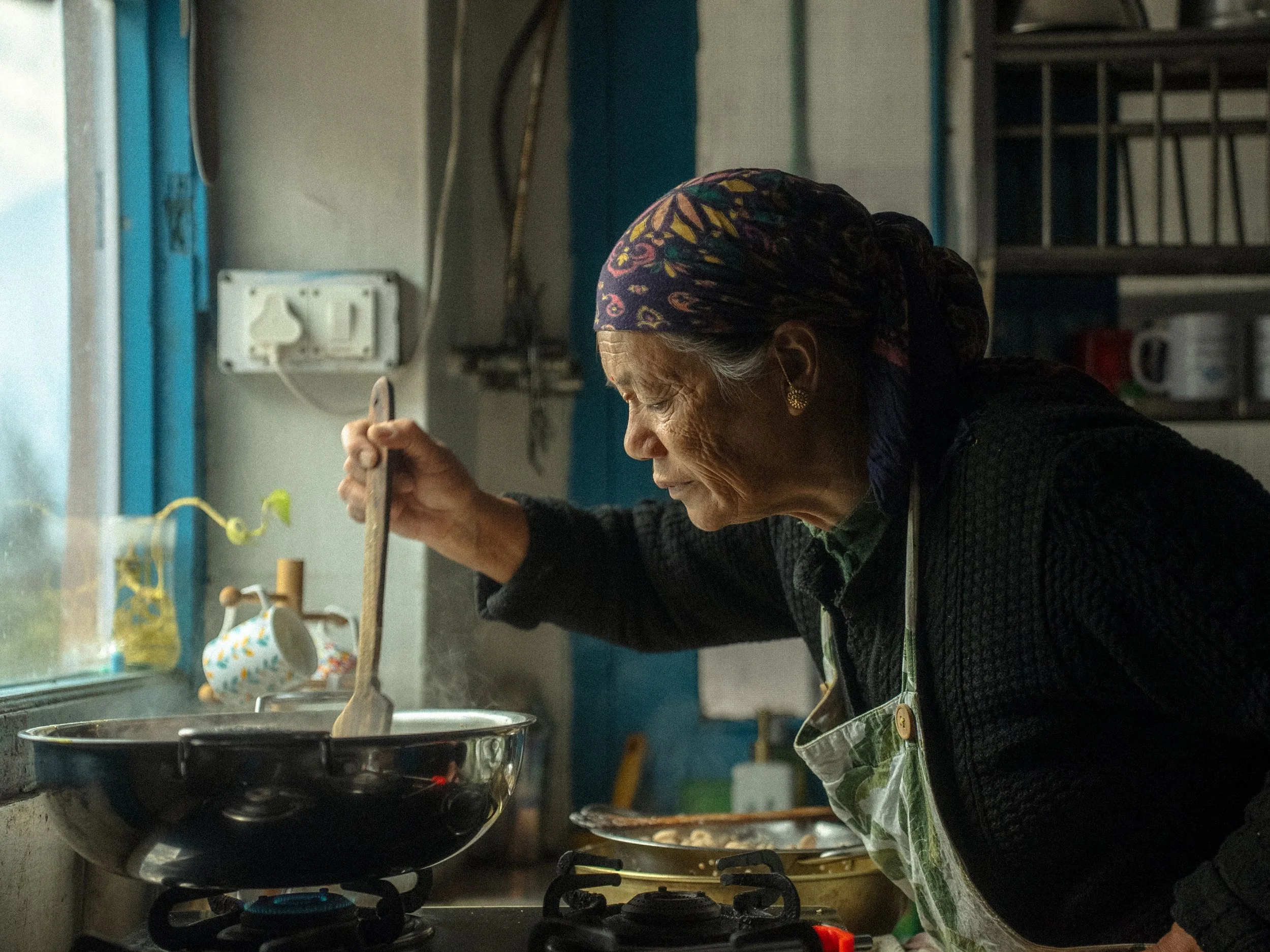What Does the Future of Bengali Food Look Like?

Chef Auroni Mookerjee is redefining and elevating Bengali cuisine whilst simultaneously digging down and getting back to its roots. Somika Basu accompanies him on a market walk, as they discuss seasonality and the need to explore Bengali cuisine beyond its stereotypes.
There’s something about the magic realism of a Kolkata bajaar.
Stepping into an otherworldly diorama, your eyes adjust to register the kaleidoscopic range of jewel-toned fruits and vegetables nestled in landscapes of rich green leaves. Rows upon rows of fish thrash in their aluminium buckets, splashing unaffected passersby. The more ambitious ones pirouette out of their containers and plop right on the market floor, to absolutely nobody's surprise. Translucent silver scales fly like confetti through the air, floating softly to the ground where they form galaxies beneath our feet. As you accept a delicate paper cup of lebu cha from an insistent vendor, you notice a few shooting stars have landed on your arm. We're all poets here. (And part fish.)
In true Bengali fashion, the morning's contemplation transitions seamlessly from poetry to potol to politics. Sipping from his thimble of sweet lemon tea, sharing anecdotes and family origin stories as we navigate the alleyways, it's easy to forget that I'm chatting with one of India's most celebrated chefs. Chef Auroni Mookerjee has been recognised for redefining and elevating Bengali cuisine whilst simultaneously digging down and getting back to its roots — all from the understated and unassuming Sienna Cafe in the bylanes of Gariahat, now ranked India's 5th best restaurant.
The bajaar to table concept is Chef Auroni Mookerjee and Sienna Cafe’s signature style
In Bengali bajaars, vendors will properly explain the distinction between vegetables
Auroni and his team are looking to the future of Bengali food, serving cheffed-up takes on familiar comfort foods made with seasonal, sensible, and sensitively-sourced ingredients. At Sienna Cafe, Auroni has been known to take even the humblest meal — a Bengali rice congee, for instance — and, with a combination of reverence, devotion, audacity and expert technique, turn it into something spectacular. This is no easy feat, given the proud, purist and discerning Bengali palate. (We're all critics here, too.)
Keen to explore Sienna Cafe's 'bajaar-to-table' process more closely, I'm following Chefs Auroni and Avi on their routine early morning market visit. The restaurant is perfectly situated to implement this idea, as the local market is literally steps away. Every self-respecting Bengali kitchen sources its ingredients from the parar bajaar or neighbourhood market. Each one is similar in terms of seasonal offerings but also quite distinct, as defined by its resident vendors.
"How many bajaars can you walk into where the vendors themselves will explain the distinction between the various begun and lebu and the best ways to cook them? We just passed three different varieties of sheem (lablab hyacinth beans) from a single stall," Auroni reflects. "And absolutely no bajaar anywhere in the country has three dozen varieties of fish on any given day — be it Mapusa in Goa, Crawford in Bombay or INA New Delhi. Those markets function as supply chains — you go there for ingredients that aren't available in your local neighbourhood market. Here, we're spoiled for choice."
The bajaar-to-table concept isn’t at all new to the Bengali home kitchen, and this feeds into Sienna Cafe's signature style while determining its ever changing menu. In Kolkata, every hyperlocal neighbourhood market is, in fact, a farmers' market. As the shoulder season nudges its way into winter, we're on the lookout for new ingredients to showcase on their upcoming menu. When the produce in the local market changes, so do Sienna’s offerings, served with a considerably more approachable, stripped-down aura than any other fine dining contemporary spot in the country.
On this particular visit, the small, slender, and modestly-priced bok maach catches Avi's eye. "I've never seen this here before," he says, turning what resembles a miniature swordfish over in his palm. "Maybe the reverse butterfly technique could work," referencing Josh Niland's manual on fish butchery and culinary sustainability.
This 'nose-to-tail' approach is a food philosophy that's been practised in Bengali home kitchens long before the phrase gained popularity, and 'root to fruit' has been the standard practice for all vegetables. (Many of us carry childhood memories of being forced, cajoled and bribed to eat straight-up fried neem leaves.) That being said, there has been a growing wave of commodification taking over the cuisine.
"It's a trend now for bars in the city to add nolen gur Old Fashioneds to their menu, but it's obviously not available outside of the winter season. Yes, there's essence, and as a restaurant we can easily have nolen gur year-round, but I think this calls for conversations that encourage people to think more about these things —because demand ultimately determines supply," says Auroni.
He urges us to consider more deeply what features on our plates at restaurants, beyond the reductive stereotypes of Bengali food. "You can't simply sous vide a medium rare piece of meat, put a koshamangsho base underneath it, and call it a contrast. How can we respect the recipes, ingredients and processes while also respecting our diners? I don't think this is a conversation that the F&B industry is having," he says.
Snaking our way through the bajaar, we bump into another of Sienna's chefs, Ankita, on her weekly exploratory visit. A defining aspect of the Sienna kitchen culture is that everyone on the team is expected to be acquainted with the local market. Driven by the desire of showcasing Bengali ingredients in surprising new ways, each member of the Sienna team is encouraged to create something of their own, avoiding the koshamangsho-fication trap of how Bengali cuisine is typically portrayed.
As Ankita reaches for a bouquet of freshly foraged dheki shaak, fiddlehead ferns, an inked rendering of the very same fronds unfurl indelibly on her inner arm. "Chef Auroni found these in the bajaar, and they've been a Sienna staple ever since," she says.
Back at Sienna Cafe, prep for the day's service has started. The vibe is Willy Wonka's Chocolate Factory meets The Bear meets your grandmother's kitchen. Someone hands me an apron featuring block prints that have appear to have leapt from the chopping board onto the fabric. The team is presenting a recent crowd favourite, the Bhetki ala Kiev, to Auroni — a dish that he conceptualised, and the execution of which has been perfected in his absence. He looks on as his team reveals the intricate technique that was finally devised to securely wrap the fish fillet around a ball of radhuni wild celery butter.
Meanwhile, Avi has deftly transformed several of his bajaar-found garfish into fried butterflies. Not completely satisfied with the results, he changes course, delicately skewering those that remain. Auroni is fielding calls from celebrities for a table later that afternoon. A fish egg XO sauce simmers in the corner, one of their secret sauces they keep on hand. (There are a few IYKYK items tucked away in the kitchen that regulars know to ask for).
But it isn't mere whimsy and wonderment emerging from the kitchen. The dishes being served at Sienna Cafe are also their contribution to the larger discourse around identity politics and conservation — examining the sociocultural roots of food with an aim to raise awareness through a thoughtfully curated, thoroughly deliberated menu. A recurring topic is their role in sustaining the local ilish population — through conscious consumption and by encouraging the diversity of palate.
"We're noticing that it's only the more traditional families and older generations eating small fish. The tastes of the younger generation are becoming increasingly gentrified and they're quite wary of them — they're just not getting into restaurants anymore," Auroni explains. "The butterfly technique on such a fish lets us take out the central bone, but retain the head and tail; it presents beautifully and can be eaten whole. We're constantly asking ourselves — how can we make things more fun and approachable while retaining the essence of what it means to eat chhoto maach in the first place. If parshey and pabda are the only small fish we serve, we aren't really influencing mindsets or the market supply chain. Our fish are becoming the equivalent of broiler chickens."
Everyone in the Sienna kitchen is encouraged to create something of their own.
By now, orders have started coming in, everyone is at their stations; the kitchen ballet is underway. Someone turns up the music that's playing in the kitchen. Between the regular cafe menu featuring their greatest hits, the weekend speakeasy small plates and the bajaar-to-table specials, it's a triple-bill performance today. This is where the creativity and boundary-breaking aspect of Auroni's style takes center stage. Fermentation meets mixology, gobindobhog metamorphoses into risotto, bhetki becomes schnitzel, and makha sandesh marries mahua treacle.
They're all poets here. And part fish.
Words and photographs by Somika Basu, a creative consultant for cultural and social development institutions. Stalk her on Instagram here.
ALSO ON GOYA


